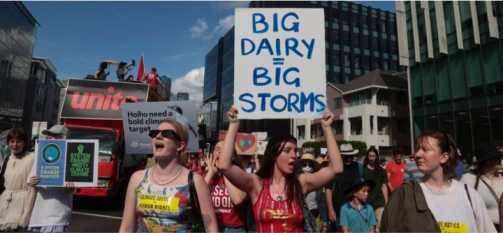Late last week, Greenpeace New Zealand held a protest outside Fonterra’s head office in Auckland.
According to Greenpeace, the area was being transformed into a flood zone and it was calling for more government action on climate change.
The “flood zone” was a few old sofas and other junk representing flood debris and a handful of people carrying placards proclaiming “big dairy, big torrent”, “climate crisis” and their good old hashtag “too many cows”.
I can only assume it was too difficult to haul several tonnes of forestry slash on Auckland’s less-than-reliable public transport system.
Say what you will about Greenpeace, and trust me I have, its message is very clear and very simple: the answer to New Zealand’s greenhouse gas emissions is to have fewer cows. In fact, just about all of Greenpeace’s agricultural protests have that aim in mind.
Nitrogen fertiliser, palm kernel and irrigation are all in the firing line, not because they are in themselves bad, but because they all support higher stocking rates and more cows. Greenpeace is nothing if not consistent.
Contrast this with Fonterra’s announcement in November that not only was it now focused on addressing Scope 3 emissions, but over 70% of its customers were too.
This announcement didn’t get much of a reaction among dairy farmers, possibly because most – myself included – were not familiar with the jargon.
Scope 3 refers to the emissions profile of the raw material you are buying, and for Fonterra this means the emissions associated with every litre of milk it collects. It means on-farm emissions, and for Fonterra on-farm emissions make up 90% of the co-operative’s greenhouse gas profile.
For Fonterra’s customers, Scope 3 means on-farm emissions plus whatever carbon footprint is added in the manufacturing and global shipping processes.
Both Greenpeace and Fonterra want to address greenhouse gas emissions, but they want to do it in very different ways. Greenpeace’s solution of fewer cows is to aim for an absolute reduction – to lower the total amount of gasses emitted simply by producing less.
An absolute reduction, however, doesn’t help Fonterra and it doesn’t help its customers. Fewer cows producing less milk but with the same carbon footprint per litre would mean the industry is just standing still, which is why milk processors all over the world are focused on intensity targets instead.
Milk processors need farmers to be more carbon efficient, to produce each litre of milk with a lower carbon footprint, or they have no way of meeting their Scope 3 goals.
Who cares, though, when New Zealand already has the most carbon-efficient producers of milk in the world? Well, we are the most efficient, but only by a very slim margin, with some states in the US and other milk-producing countries like Ireland poised to overtake us.
Fonterra’s customers like international conglomerates Mars, purveyors of M&Ms, care very much indeed. Mars is under immense pressure to reduce its Scope 3 emissions too, and with 20% of that coming from the dairy products it buys, it is very serious about sourcing the lowest footprint dairy it possibly can.
If Fonterra and New Zealand can’t meet Mars’ demands, there are many others queueing up to do so.
Mars is so serious that it has identified the most carbon-efficient milk-producing region in New Zealand and would like to source its raw materials from that region exclusively.
If that is happening right now on a regional level, it doesn’t take much imagination to forecast what would happen globally if New Zealand lost the number-one ranking for efficiency.
There are obvious tensions between intensity targets, producing milk more efficiently and absolute targets, but simply cutting production for the sake of lowering total emissions is a fool’s game that would harm our agricultural producers and the broader economy.
It also feels like the lazy way out. Farmers have a history of adaption and innovation and this is just another – albeit significant – challenge to be met.
There’s a reason Greenpeace’s solution can fit on a placard and Fonterra’s requires roadshows, webinars and careful explanation: the answers to complex problems can rarely be found in a hashtag.
Source : Stuff.nz March 20th 2023

